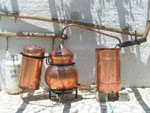
I managed to locate an excellent source for wild crafted aromatic raw materials. This is very exciting to me, as it opens a door for access to some very interesting plants, some of which I've wanted to distill for a very long time. Included in that list is Wild Ginger (Asarum canadense), Arrow Leaf Balsam Root (Balsamorhiza sagittata), Pipsissewa - Prince's Pine (Chimaphila umbellata) and of course one of my favorites, Incense Cedar (Libocedrus decurrens-- aka Calocedrus decurrens)

I started distilling a batch of Incense Cedar Leaf. The leaf had been gently dried and there was minimal stem material. This is very good, because the twigs are unproductive and take up room and cost energy. I distilled for three hours and obtained less than 0.5% yield. Then it dawned on me that I had made an error.
As with all conifers, the scales of the "leaf" of the Incense Cedar are covered with a waxy coating. In order to break the coating down and get at the essential oils the coating protects, the "leaf" must first be soaked in room temperature water.
I turned off my distiller, and left the steam soaked plant material to sit overnight. When I distilled the next morning, the essential oil flowed easily.
I finally ended up with a 1.4% yield of essential oil and lots of interesting hydrosols.
When I do my next run of Incense Cedar Leaf, I will add copper to the system to reduce the sulfurous "still note". The last time I distilled Incense Cedar was in a copper still and the oil was "sweet" right from the beginning. I will also soak each batch for at least 12 hours prior to distillation.
Right now the oil and waters are breathing, like a fine wine.
I hope in the future to be able to increase the percent yield to between 1.5 and 2.0 %.

Cant' wait to distill Wild Ginger and Arrowleaf Balsamroot!

 I managed to locate an excellent source for wild crafted aromatic raw materials. This is very exciting to me, as it opens a door for access to some very interesting plants, some of which I've wanted to distill for a very long time. Included in that list is Wild Ginger (Asarum canadense), Arrow Leaf Balsam Root (Balsamorhiza sagittata), Pipsissewa - Prince's Pine (Chimaphila umbellata) and of course one of my favorites, Incense Cedar (Libocedrus decurrens-- aka Calocedrus decurrens)
I managed to locate an excellent source for wild crafted aromatic raw materials. This is very exciting to me, as it opens a door for access to some very interesting plants, some of which I've wanted to distill for a very long time. Included in that list is Wild Ginger (Asarum canadense), Arrow Leaf Balsam Root (Balsamorhiza sagittata), Pipsissewa - Prince's Pine (Chimaphila umbellata) and of course one of my favorites, Incense Cedar (Libocedrus decurrens-- aka Calocedrus decurrens)
 I started distilling a batch of Incense Cedar Leaf. The leaf had been gently dried and there was minimal stem material. This is very good, because the twigs are unproductive and take up room and cost energy. I distilled for three hours and obtained less than 0.5% yield. Then it dawned on me that I had made an error.
As with all conifers, the scales of the "leaf" of the Incense Cedar are covered with a waxy coating. In order to break the coating down and get at the essential oils the coating protects, the "leaf" must first be soaked in room temperature water.
I turned off my distiller, and left the steam soaked plant material to sit overnight. When I distilled the next morning, the essential oil flowed easily.
I finally ended up with a 1.4% yield of essential oil and lots of interesting hydrosols.
When I do my next run of Incense Cedar Leaf, I will add copper to the system to reduce the sulfurous "still note". The last time I distilled Incense Cedar was in a copper still and the oil was "sweet" right from the beginning. I will also soak each batch for at least 12 hours prior to distillation.
Right now the oil and waters are breathing, like a fine wine.
I hope in the future to be able to increase the percent yield to between 1.5 and 2.0 %.
I started distilling a batch of Incense Cedar Leaf. The leaf had been gently dried and there was minimal stem material. This is very good, because the twigs are unproductive and take up room and cost energy. I distilled for three hours and obtained less than 0.5% yield. Then it dawned on me that I had made an error.
As with all conifers, the scales of the "leaf" of the Incense Cedar are covered with a waxy coating. In order to break the coating down and get at the essential oils the coating protects, the "leaf" must first be soaked in room temperature water.
I turned off my distiller, and left the steam soaked plant material to sit overnight. When I distilled the next morning, the essential oil flowed easily.
I finally ended up with a 1.4% yield of essential oil and lots of interesting hydrosols.
When I do my next run of Incense Cedar Leaf, I will add copper to the system to reduce the sulfurous "still note". The last time I distilled Incense Cedar was in a copper still and the oil was "sweet" right from the beginning. I will also soak each batch for at least 12 hours prior to distillation.
Right now the oil and waters are breathing, like a fine wine.
I hope in the future to be able to increase the percent yield to between 1.5 and 2.0 %.
 Cant' wait to distill Wild Ginger and Arrowleaf Balsamroot!
Cant' wait to distill Wild Ginger and Arrowleaf Balsamroot!


